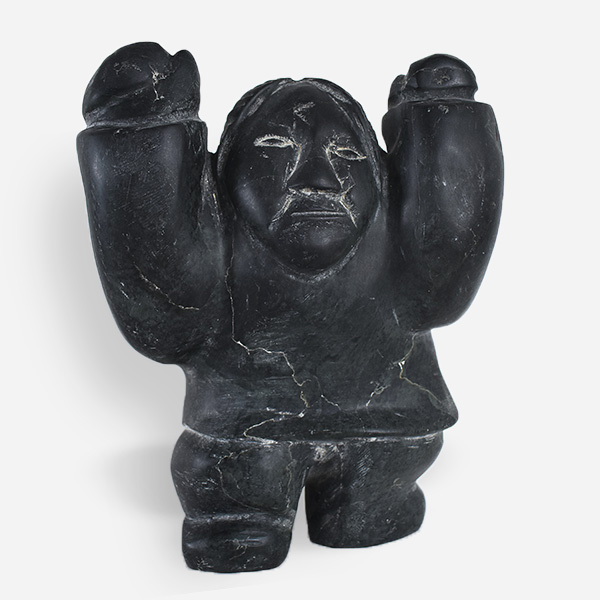
Norval Morrisseau
Norval Morrisseau, born in Sandy Lake, Ontario in 1932, painted prolifically until his death in 2007. As a member of the Indian Group of Seven, Morrisseau, also known as “Copper Thunderbird”, founded the Woodlands School of Canadian art. This school of art is characterized by thick black outlines, bright colours and undifferentiated backgrounds. Known as the “Picasso of the North”, Morrisseau created works depicting the legends of his people, the cultural and political tensions between Native Canadian and European traditions, his existential struggles, and his deep spirituality and mysticism. Morrisseau is perhaps the most celebrated and illustrated artist in Canadian history. His works are exhibited in international galleries and he has been the subject of many books and documentaries.
Dennis Bruce
Dennis Bruce was born in Lestock, Saskatchewan and was a member of the Muskowekwan First Nation Band (Saulteaux). His work is characterized by bright, colorful, and powerful haunting images of warriors, family and stylized landscapes and animals. He was influenced by various contemporary Native artist’s and developed his own unique and expressive style which was, unfortunately, cut short when he passed away of cancer at a young age.
Daphne Odjig
Daphne Odjig was born in Wikwemikong, on the Manitoulin Island, Ontario. She became interested in painting at a very young age and was influenced and mentored by her paternal grandfather, Jonas, with whom the young family lived. He nurtured her creative spirit and inspired her to follow her passion. In 1960 she received acknowledgement of her work for her pen and ink drawings of Cree Life in northern Manitoba. It was not until she started exploring the legends and spirituality of her people that she started painting in the Woodland School of Canadian art tradition. As a founding member of the Group of Seven, her paintings documented the struggles and joys of First Nation life and plurality. She combined both contemporary North American and European influences in her work, especially the works of Picasso, Van Gough and Emily Carr. She has received numerous prestigious awards and was a founding member of the Professional Indian Artists Association. Her works are held by public galleries throughout the world and her work is featured in many books and documentaries.
The Keewatin region
The Keewatin region lies within Nunavut, north of Churchill, Manitoba on the west coast of the Hudson Bay. It is the home of some of the most famous Inuit art communities in Canada. Baker Lake, Rankin Inlet, Arviat, formerly Eskimo Point, and Repluse Bay have produced exceptional numbers of famous artists that are part of the Canadian Art mosaic. Such great artists as John Tiktak, John Kavik, Andy Miki, John Pangnark, Peter Seevoga, Elixabeth Nutaraaluk, Lucy Tasseor, Barnabus Arnasungaaq, Miriam Qiyuk, Jessie Oonark, Victoria Mamnguqsualuk , Josiah Nuillakik, Tuna Iquliq, George Tataniq, Mark Tungilik, George Arluk, Mathew Aquigaaq, Luke Iksiktaaryuk and others have dominated the Inuit art scene since its inception in the early 1950’s. Keewatin Inuit art differs from community to community. Repulse Bay is known for its finely polished stone and ivory images, Rankin Inlet for its raw, rough and powerful unfinished carvings, Baker Lake for its beautifully black finished surfaces and Arviat for its unfinished, abstract minimalist carvings made famous by John Pangnark, Lucy Tasseor and Andy Miki. Although different in style and presentation, Keewatin works of art share the same theme – the depiction of family and traditional life style.
Roy Thomas
Roy Thomas, an Anishinaabe painter was one of the most influential aboriginal artists in Canada, and was famous for paintings of colourful animals and native traditions. Like Norval Morrisseau, he was a member of the Group of Seven and painted in the style of the Woodlands School of Canadian Art. His work became well known when Canadian Native art gained mainstream popularity in the late 1960s and early 1970s. He kept painting until his untimely death from cancer in 2004.
Simon Tookoome
Simon Tookoome, born in 1934 moved to Baker Lake from Chantrey Inlet, in 1960 after his people were threatened with starvation. In 1969, Simon began to draw and carve and became a founding member of the Baker Lake Sanavik Co-op. He is mostly known for his drawings and prints that depict hunting, Shamanist transformations and traditional Inuit ways of life. Artistically, Tookoome combines patterns, colours, lines and form to produce sweeping harmoniously balanced images that reach into another world. Exhibitions of his works have travelled to Isreal, Germany, USA, France and Japan.
Victoria Mamnguqsualuk
Victoria Mamnguqsualuk was born in Garry Lake, NWT and moved to Baker Lake, Nunavut, in 1963 during the widespread famine and disease in the Central Arctic. Daughter of one of the most famous artists, Jessie Oonark, Victoria developed her own unique style of drawing by depicting Inuit legends and myths. Her drawings are bold, mystical, complex and filled with Inuit folklore. Her works are collected and displayed in many galleries and private collections.

